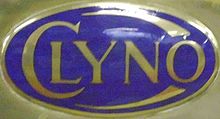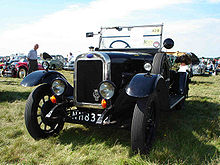Clyno
The Clyno Engineering Company Ltd , founded by Frank Smith , developed from a motorcycle manufacturer to an automobile manufacturer in the 1920s and was the third largest automobile manufacturer in Great Britain in 1926. Based on Pelham Street in Wolverhampton , the company manufactured more than 40,000 cars from 1922 to 1929.
Clyno gear
These were continuously adjustable belt drives for use in industry and later also in motorcycles . The rollers were manufactured in 1909 by cousins Frank and Ailwyn Smith at their Clyno Engineering Company in Thrapston, Northamptonshire .
motorcycles
In 1910 complete motorcycles with Stevens engines were built. Stevens went into voluntary liquidation in 1910 and the Smith cousins bought his factory on Pelham Street in Wolverhampton. In 1912 they expanded into the adjacent, former Humber bike factory. During the First World War , the company received many orders for motorcycle combinations with Vickers machine guns . With the growth of automobile production, motorcycle construction was given up in 1923.
Automobiles
The first and most important car model, the 10.8 , designed by AG Booth , had a side-controlled four-cylinder engine with 1368 cc from Coventry Climax with a carburetor from Cox Atmos and a manual three-speed gearbox. At first there was no differential, but it was soon retrofitted. From 1926 the car had four-wheel brakes as standard. The vehicles were known for their reliability and economy. Approximately 35,000 copies were made, including some sport versions and luxurious Royal models.
A slightly larger model, the 13 (later 12/28 ), but still having the same wheelbase of 2667 mm, was introduced in 1924. It had an engine from its own production with a 69 mm bore (3 mm more than the 10.8) and the same stroke of 100 mm. This resulted in a displacement of 1496 cm³. Approx. 8000 pieces were made.
A new factory in Bushbury , a suburb of Wolverhampton, was added in 1927, and with it two new models. The 12/35 had a machine bored out to 69.5 mm (1593 cm³ displacement), presumably to take into account the higher weight of larger bodies, although most of the superstructures were probably made of synthetic leather.
The last car was the little 9 with a synthetic leather body and 951 cc engine. The Century version (later nicknamed "Cemetery") was an attempt to make a car for only £ 100, but the quality suffered and the Great Depression caused sales to collapse, especially as there was serious competition from Austin 7 and from the Morris Minor .
The company made another rescue attempt and built the prototype of an eight-cylinder in-line engine, but it never got ready for series production.
Car models
| Type | engine | approx production | Construction year | price | Remarks |
|---|---|---|---|---|---|
| 10.8, 11 and 11.9 | 1368 cc Coventry Climax SV four-cylinder | approx. 35,000 | 1922-1928 | £ 152 (1928) touring car | Cone clutch, separate three-speed gearbox, four-wheel brakes from 1926, the first cars had no differential |
| 12, 13 and 12/28 | 1496 cc SV four cylinder | 8000 | 1923-1927 | 215 lb chassis | Clyno gear |
| 12/35 | 1593 cc SV four cylinder | 2000 | 1928 | £ 157 | 12 volt electrical system |
| 9 | 951 cc SV four cylinder | 300 | 1928 | £ 145 touring car, 4 seats £ 160 sedan |
Three-speed gearbox interlocked with the engine, Weymann body |
Decline
The main dealers were the Rootes brothers who eventually tried to buy the company. From 1928, however, they decided to focus on Hillman , which led to the demise of Clyno.
In 1929 Clyno had to file for bankruptcy and the remains were bought up by the Birmingham- based company RH Collier .
Web links
Individual evidence
- ↑ a b Georgano, N .; Encyclopedia of the Automobile , HMSO, London (2000), ISBN 1-57958-293-1
- ↑ a b c d Baldwin, N .: AZ of Cars of the 1920s , Bay View Books, Devon (1994), ISBN 1-87097-953-2



